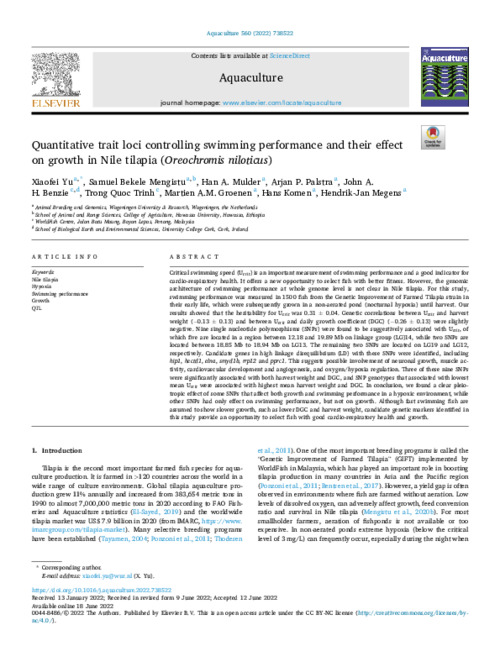Quantitative trait loci controlling swimming performance and their effect on growth in Nile tilapia (Oreochromis niloticus)

Critical swimming speed (Ucrit) is an important measurement of swimming performance and a good indicator for cardio-respiratory health. It offers a new opportunity to select fish with better fitness. However, the genomic architecture of swimming performance at whole genome level is not clear in Nile tilapia. For this study, swimming performance was measured in 1500 fish from the Genetic Improvement of Farmed Tilapia strain in their early life, which were subsequently grown in a non-aerated pond (nocturnal hypoxia) until harvest. Our results showed that the heritability for Ucrit was 0.31 ± 0.04. Genetic correlations between Ucrit and harvest weight (−0.13 ± 0.13) and between Ucrit and daily growth coefficient (DGC) (−0.26 ± 0.13) were slightly negative. Nine single nucleotide polymorphisms (SNPs) were found to be suggestively associated with Ucrit, of which five are located in a region between 12.18 and 19.89 Mb on linkage group (LG)14, while two SNPs are located between 18.85 Mb to 18.94 Mb on LG13. The remaining two SNPs are located on LG19 and LG12, respectively. Candidate genes in high linkage disequilibrium (LD) with these SNPs were identified, including hip1, hectd1, elna, smyd1b, rrp12 and pprc1. This suggests possible involvement of neuronal growth, muscle activity, cardiovascular development and angiogenesis, and oxygen/hypoxia regulation. Three of these nine SNPs were significantly associated with both harvest weight and DGC, and SNP genotypes that associated with lowest mean Ucrit were associated with highest mean harvest weight and DGC. In conclusion, we found a clear pleiotropic effect of some SNPs that affect both growth and swimming performance in a hypoxic environment, while other SNPs had only effect on swimming performance, but not on growth. Although fast swimming fish are assumed to show slower growth, such as lower DGC and harvest weight, candidate genetic markers identified in this study provide an opportunity to select fish with good cardio-respiratory health and growth.
Permalink
Date Available
Type
Publisher
Countries
ISSN
0044-8486,1873-5622
Copyright
CC-BY-NC-4.0
Research Themes
Topics
Language